This afternoon, Zinnia made her debut at Bishop Gibbons High School in Schenectady; I was never prouder of her. She was a smash.
In one sense, it was my worst fear as a therapy dog handler.
Scores of dog-loving students from the sixth grade to the ninth begged for permission to come to the art studios to meet her, and Sue Silverstein, who loves Zinnia so much I had her implanted with a computer chip just in case (kidding, sort of), told them all to come.
But I had nothing to fear. Zinnia is the Queen of Chill, and as a therapy dog, she is also a champion. I could not have been happier or more touched by her work than I was today. These kids love her and need her. So do I.
That was a tremendous test for her; she got an A plus. I wasn’t shocked by her poise and calm, but I never take anything for granted in therapy dog work. She’s been to the school once briefly in the summer when we came to help Sue unload her art supplies.
But she’s never met with any students there before today.
They love dogs at Bishop Gibbons; Zinnia got more attention, swarming, grabbing, patting, and crowding than she had ever experienced at Bishop Maginn or the Mansion or anywhere. She was a champion, calm, relaxed, loving, and sensitive to every child.
Two or three times, students told me they were afraid of dogs, and they hung back. I said, ” let me help you, ” and Zinnia, with her impeccable radar, came gingerly over to them and licked their hands and, if they got low enough, their chins.
She never lunged or started, she let them come to her and flipped every one of them in minutes. At least a dozen kids asked if I could bring Zinnia on exam days to help them relax.
I’ve always thought of Zinnia as a remarkably grounded dog, the product of great breeding and a lot of therapy work and practice. The biggest crowd came as soon as we arrived, and Zinnia worked for the group beautifully and thoroughly. The treats Sue slipped, and the treats at first were not hurting anything either.
I forbid feeding therapy dogs and am almost universally ignored, especially by children. It is really too much to ask, but I don’t want the dog to focus on the food rather than the people, which can happen easily.
Zinnia has significant boundaries around this issue. She takes the food happily – she is a Lab – but when it ends, she works for the crowd and is happy to be touched and goes to work.
In my experience, therapy dogs tire somewhere between 30 and 45 minutes. Although it looks easy, it isn’t for dogs or for me. It is exhausting and intense work, done correctly, and Zinnia does it as well as any dog I have had or seen.
The handler needs to know when enough is enough. I never want to test a dog too much with children, in hospice, or assisted care.
(In this photo, a young student who says he is terrified of dogs approaches Zinnia slowly and carefully, and he takes his time as I suggested. She sat still, licked his hand, and let him stroke her nose and head. Five minutes later, he was on the floor kissing Zinnia on the nose. She licked him on the nose in return.)
Even for the Queen of Chill, this was good work. My standard for my therapy dogs is zero mistakes. One growl, one jump on someone, one snarl or showing of teeth, one act of disobedience, and the therapy work stops for good.
(In between the crowds when the school bells ring, two girls entered an empty classroom and had a private session with Zinnia, who was beginning to tire. She’d been mobbed for an hour and a half longer than ever before. I could tell by the panting that she was tired. The girls were quiet and gentle, so they got a sweet, private audience.)
The best therapy dogs have natural solid instincts for work, intuition, empathy, and a good sense of distress or need.
The trainer’s job is to support and strengthen those tendencies, many of which just cannot be taught. The handler’s task is to show the dog what the work is – people, not food – and reward the proper response. That means I must always pay attention to the dog, which people often don’t understand.
Zinnia gets who wants to see her and who doesn’t, and I’ve never seen her approach someone who is afraid of dogs or doesn’t want her to get close. She has excellent radar for that; she reads people instantly and sufficiently.
One of the great things about Zinnia is that when she is tired, she can sleep anywhere. When our tour ended, we went back where we started, to the art room. Zinnia lay down behind my chair and went to sleep until we left. Students were laughing and banging things all around her as they made their a
Several students entered, petted her, and scratched her belly or head; she looked at them, licked a hand or two, and went back to sleep.
It was a truly exhilarating debut for me. I told the kids the school now had their therapy dog, which was Zinnia. There were loud cheers. The Queen of Chill is back on the job.
(If you’re interested in training your dog to be a therapy dog, e-mail me at Dog Support, jon@bedlamfarm.com and I’ll take it from there. The fee is $50 per half hour.)


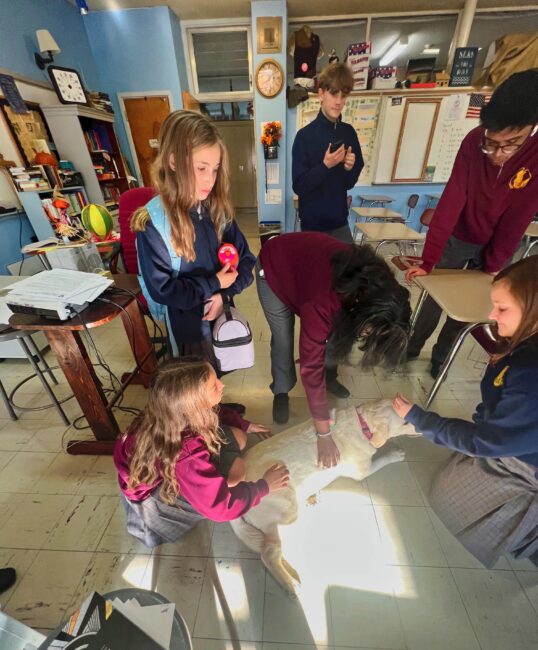
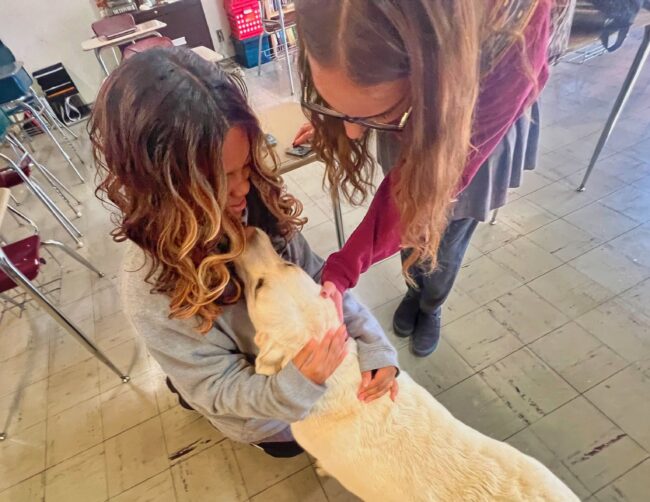
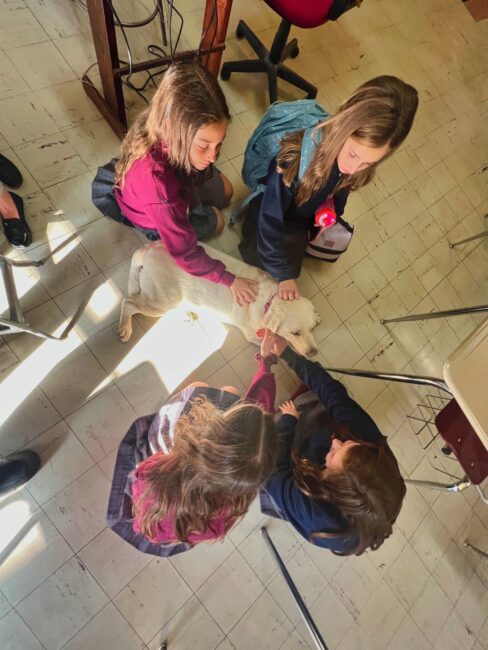
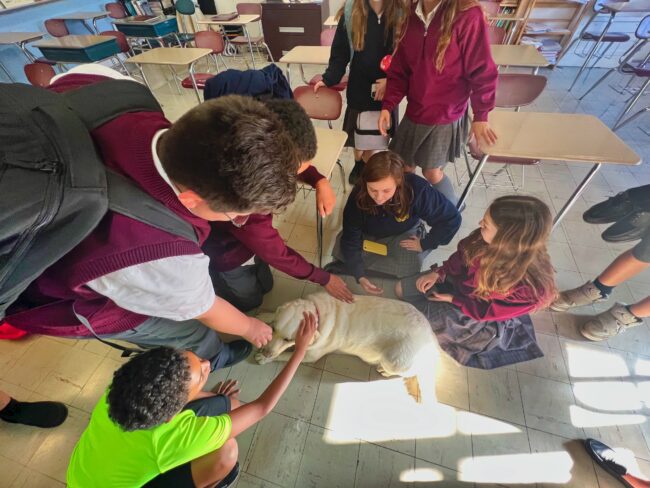
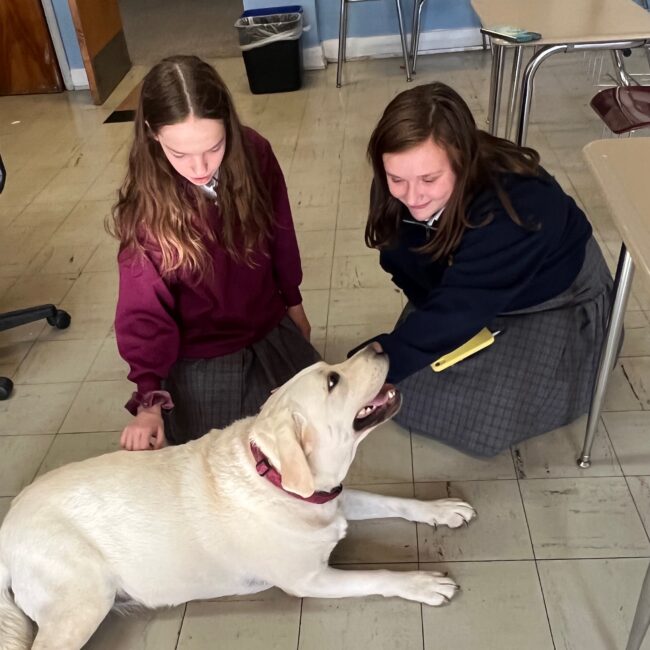
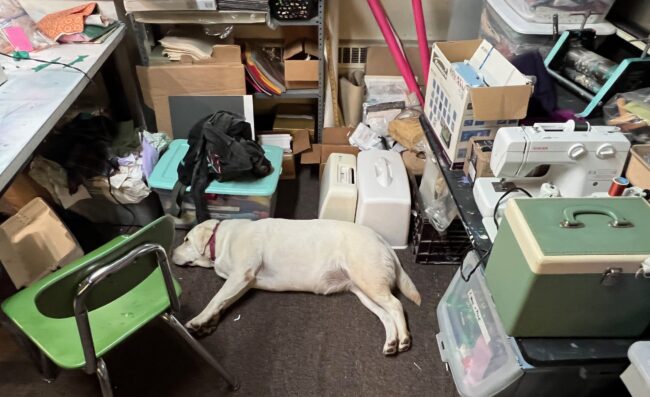
as you say, Zinnia is a testament to not only good breeding, but to good handling and training. Kudo’s to you. and accept the accolades for that too! i believe you sound like a very proud *Dad*…….and you should, deservedly so. Bless her big heart. She’s got what it takes and she reads cues so perfectly. She does great good, as do you
Susan M
Awwww – that is so awesome. I can’t tell who is enjoying it the most in that first picture – Zinnia or the kids! Obviously both. What a blessing! Thank you for sharing this special time with us. I adore Zinnia – as well as Fate and Bud – but especially Zinnia.
Thank you on behalf of Therapy Dogs everywhere for being so sensitive to their needs. I agree that therapy is very taxing to both members of the team. Love to you both.
What a great joy, Jon!
She’s an old pro.
What more can you say?
She’s actually pretty young; turned three recently. I think she was born a pro. 🙂
She’s an old pro.
What more can you say?
Thanks she’s actually a young pro just three